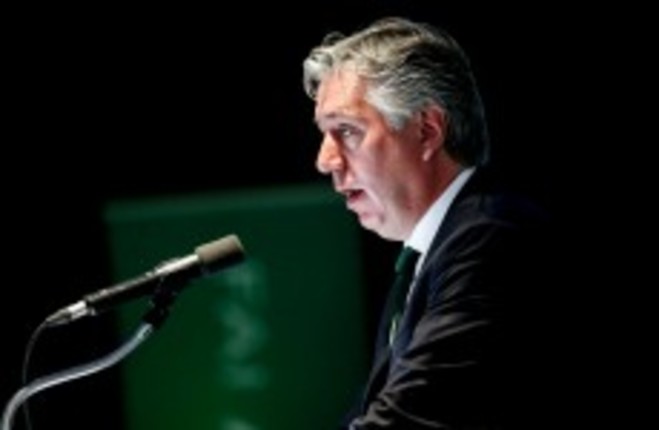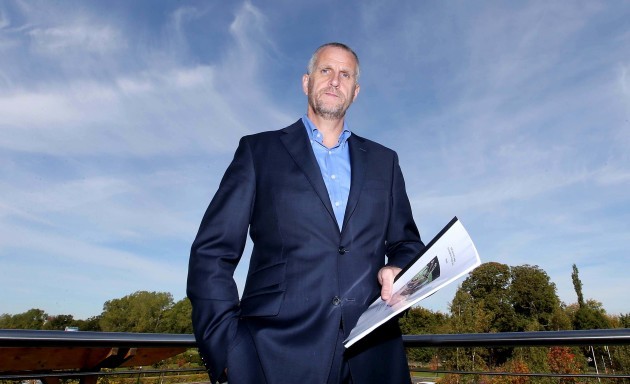AFTER SPENDING THE past number of months consulting with those at the heart of Irish football, Declan Conroy has been relaying his findings to anyone who will listen over the past 24 hours.
At the start of the season, the man who played an integral part in bringing both the 2011 Europa League final and Euro 2020 to Dublin was tasked with producing a report on the current state of the League of Ireland by the FAI.
The long-term aim?
Healthier attendances at popular events which are well run by sustainable clubs and have high quality football played by players and clubs, strongly embedded in their communities.”
He spoke with nearly 200 people from the 20 current SSE Airtricity League clubs — including players, managers, supporters and volunteers — to find out 1) how they operate, and 2) how best they can move forward.
The 75-page document was released online last night as Conroy presented his report to the clubs before appearing on Soccer Republic to discuss it with a number of interested parties.
“What I’m sensing from last night’s meeting with the clubs is that there was a positive mood in the room,” Conroy said today.
“Were there a few gasps in terms of the recommendations? Yes. Are there challenges? Yes, but I think their reaction by in large was good that they feel issues have been addressed.
“Is there a potential way forward here or and is there something that we’ve got to talk about to move forward progressively? That seemed to me to be the case but time will tell.”
This afternoon, it was the media’s turn to hear from the PR and communications expert during a press briefing at Castleknock Hotel and Country Club.
Listing his discoveries under seven headings, Conroy outlined which areas he feels the domestic league is doing well and where there is room for improvement.
The current league structures, club finances and the spread of prize money, the length of players’ contracts, the over-reliance on non-paid or part-time volunteers, attendances, TV money, sponsorship and marketing were all touched upon.
He recognises three key areas essential to sustainability — sport, business and commercial and community relations.
The league is where it is and different people have their own opinion on how good or bad it is and I tried to reflect that in the report,” Conroy says.
“It sets out a vision for where I think, and the clubs think, the league should be — which is to be successful. What is success? Club A will have a different idea to Club B.
“When I asked a member of one club what they considered success for the league, they said ‘better attendances at all games for all clubs’. That was a remarkably positive and unselfish thing to say.
“It was saying ‘if my club is competing in the league with better attendances across the board then we will have a better product with money coming in the gate and all clubs will be sustainable’.
“This is not about trying to see how one club can qualify for Europe on a regular basis. It’s about having a sustainable league by putting in more focused structures.”
As the FAI’s ten-year merger with the League of Ireland is up at the end of 2016, he suggests four possible options to move forward. They are:
- Maintain the status quo – rolling over existing structures
- Disband the merger – with the running of the League returning to the clubs
- Start again – with a radical, centrally controlled, regional, franchised model
- Create a new league structure, with a new match format, new brand, new marketing approach and new standards in football club administration as part of a strategic plan for the league to 2020.
He recommends implementing Option 4 and includes detailed short-term (2016), medium-term (2017-2020) and long-term plans (2019-2020).
A re-structure would see the Premier Division cut from 12 teams to ten with the two clubs joining the First Division.
Controversially, that would mean three or four clubs need to be relegated next year and one or two would come up from the second tier.
With his work done, Conroy stresses that the next step is for the clubs and the FAI to sit down and iron out what is best for all parties involved.
“From what I picked up last night, the clubs will go back and read the report in detail and talk amongst themselves,” he adds. “Likewise the FAI.
“The fact that there are a couple of options means they will have to decide if they go for one of them, or a variety of a few. If somebody says ‘we’ll take a bit of Option 3 and a bit of Option 4′ then I’m okay with that. If they feel it works for them then so be it.
In terms of implementation, that will come out of a collective process between the clubs and the FAI so that’s up to them.”
FAI chief executive John Delaney has this evening released a statement welcoming the findings and labelling the report “the most comprehensive and thorough review of senior domestic football in Ireland”.
“I want to thank the Board of the FAI for commissioning this report,” Delaney added. “This marks a very important analysis of the current landscape and potential pathways forward for the SSE Airtricity League.
“I want to pay tribute to the clubs, who were presented with the report on Monday, in what was a very constructive meeting, and I want to thank them for their imputs.
“We now look forward to working with the clubs to agree a process to discuss the consultation document in detail, and the Association will be writing to the clubs this week to establish a timetable to move forward.”
Whatever is decided upon, few will argue that the league is in dire need of a shake-up and an injection of fresh ideas. But does Conroy believe his report will bring about the much-needed change?
“We’re at a point in time where one way or another the merger is up in 2016 so an agreement of some description has to be made from 2017 onwards,” he says.
“This is just one pathway. It doesn’t necessarily mean it was the best or the right one. It’s the one I came up with through the process and if somebody else has a better one arising from discussions around my report then happy days.
“If it leads to a better league, then I’ll be delighted.”
Read the Conroy Report in full here and 17 things we learned from it here


